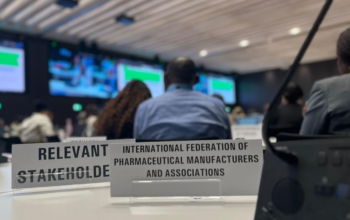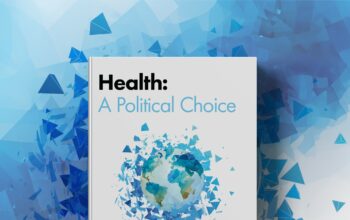Five priorities for future pandemic preparedness and response

This oped was originally published on Pharma Boardroom on 16 February 2023
The international community is working to re-build the global health architecture to ensure it is fit-for-purpose to prepare and respond to future health emergencies. Actors across the health sector have been leveraging their experiences and sharing their views on how to best articulate and agree on a framework that ensures everyone, everywhere is protected and no one is left behind.
As part of these discussions, the innovative pharmaceutical industry has shared lessons learned from COVID-19 to build on for better future pandemic preparedness and response. The International Federation of Pharmaceutical Manufacturers & Associations (IFPMA) has recently outlined five priorities critical to develop and deploy countermeasures even faster and more effectively than it happened with the COVID-19 pandemic, and achieve greater health equity from the outset of future pandemics.
Sustaining a thriving innovation ecosystem
First, mindful of the time, investments required and risks to develop safe and effective countermeasures, sustaining a thriving innovation ecosystem which fosters a continued drive of innovation ahead of the next pandemic, is of the utmost importance. We want to develop new pandemic countermeasures even faster, as proposed in the 100 Day Mission . Such aspirations require sustaining a thriving innovation ecosystem that can be counted on and guaranteeing fast, certain, and unencumbered access to pathogens and their genetic information.
Intellectual property incentives are critical to this kind of ecosystem on which global health security can depend. They provide the necessary framework that makes at risk investments possible in advance of the next pandemic, as well as facilitating voluntary partnerships, business-to-business agreements, technology transfer to scale up for high volume supply.
This ecosystem is amongst the things that worked well at the onset of the COVID-19 pandemic and allowed the rapid development and scale-up of vaccines and treatments in record time. The first COVID-19 vaccine was approved for emergency use only 326 days after the genetic sequence of SARS-CoV-2 was released. This was the fastest vaccine development ever, slashing by a fifth the previous record. But next time, we want to react even quicker, in just 100 days after a new pandemic threat is identified. But to do so, a broad and deeply competitive ecosystem must be maintained. It is the mechanism that will allow pharmaceutical companies to face the risks, failures, and uncertainties of future innovations for the development of novel vaccines and therapeutic tools for pandemics and beyond.
Potentially undermining the success of 100 Days Mission plans is the increased politization of pathogen-sharing discussions. There is a misunderstanding of how the legal framework for pathogens should be governed, with some countries placing value to pathogens instead of global health security which requires rapid sharing of pathogens and their genetic sequences. We should avoid discussions under transactional model-based laws. Benefit-sharing concepts designed to protect biodiversity should not be linked to access to pathogens.
Building equitable access early on into pandemic responses, shaping a new “social contract”
Guaranteeing the timely development and production of countermeasures is not enough, we also need to ensure equitable roll-out. As demonstrated by the COVID-19 pandemic, this cannot be done once the crisis has already hit. Dose-sharing must be built-in from day 1. As outlined in the Berlin Declaration , the industry is willing to reserve an allocation of real-time production of vaccines and treatments for future pandemics for priority populations in lower income countries and take measures to make them available and affordable.
The Berlin Declaration, launched by IFPMA, has now also been supported by the Biotechnology Innovation Organization (BIO) and the Developing Countries Vaccine Manufactures Network (DCVMN). However, for this to work, we need the buy-in from political leaders, from G7, but also G20 countries and all countries with manufacturing capacity currently negotiating the pandemic accord. Political leaders need to sign up to a “social contract”, allowing that part of what’s produced in their territories will be used for priority populations in low-income countries in real time, and not only after their own needs are serviced.
Fostering sustainable manufacturing globally
Critical to ensure equitable access is the ability to scale-up production to high supply volumes in pandemic times. For this, there is a need to foster sustainable manufacturing globally by maintaining existing capacity and introducing new capacity in currently under-served regions. The right enabling environment to attract sustainable investments and predictable demand, and a robust intellectual property protection framework to fast-track partnerships, voluntary licensing and/or tech-transfers will be critical in this regard.
Removing barriers to trade
The need for a robust, agile and diverse global supply chain and logistics network is clear. To further enhance the global supply chain, we should focus on streamline regulatory processes, expedite the free movement of vaccines, treatments, and their raw materials and supplies, as well as the movement of skilled workforce.
We need to work together to create standard operating procedures for predictable allocation, on-the-ground distribution optimization, air cargo operations, customs clearance and other national requirements. We also need to develop strategies to strengthen country’s supply chains. All these components will have a major impact in making vaccines, treatments and diagnostics available once they have been approved and are ready to deploy.
Ensuring greater country readiness
With COVID-19, we have seen many countries struggling to get vaccines “from ports to arms”. Health systems need to be stronger and resilient so that they can rapidly absorb and deliver vaccines and medicines to those who need them most, while maintaining continuity of care. In addition, for vaccination campaigns to be successful, people need should feel confident in their governments.
Investing in key health system capabilities, including life-course immunization programs and sustained investments in primary health care (PHC), and in training community health workers will be critical. This must go hand in hand with plans to build health security core capacities, such as improving disease surveillance, building laboratory testing capacity, and capacity for emergency risk communications.
A new global health architecture
Key discussions on the future of the global health architecture will be ongoing in the next months. These efforts and practical solutions to strengthen our collective capabilities to prevent, detect, and respond to future threats are underpinned by the need for collaboration.
A multistakeholder approach is the only viable solution to managing pandemic crises, and the new global architecture should build on the private sector’s strengths for innovative R&D, quick manufacturing scaling up and distribution.
In 2023, IFPMA will consistently continue to advocate and work towards these five priorities within pandemic accord discussions and beyond, ensuring that the innovative pharmaceutical industry has a seat at the negotiations table, and can fulfil its unique role.
Author






